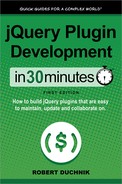This brings us to an end on jQuery plugin development and extending the jQuery $.fn object. Below we have included the full boilerplate code with comments that you can use as a starting point on your plugins. You can also get the code on GitHub at https://github.com/websanova/wBoiler where the latest version of the boilerplate is maintained.
// Make sure we have a closure so that we don't have any conflicts
// with our plugin class and prototype or any other functions.
(function ($) {
// Its a good idea to use `strict` to reduce number of errors
// in your plugin and code in general.
'use strict';
// Plugin function class. This object will hold the properties
// for each instantiation of the plugin.
function Boiler(el, options) {
this.$el = $(el);
this.options = options;
// Occasionally useful to track the initialization of our plugin.
// Useful if we want specific things to happen or not on initialization.
this.init = false;
// Call our generate method to setup the plugin.
this._generate();
}
// Prototype our class. This shares the core code between all
// instantiations of our plugin. The majority of our code will
// live here.
Boiler.prototype = {
_generate: function () {
var _this = this;
// Visual setup should be here. If you have many components
// it's a good idea to break it up into functions however keep
// the core of it here.
this.$boiler = $('<div></div>'),
this._setOptions();
// Probably will append something at this point.
$('body').append(this.$boiler);
// Set init to true so that we now our plugin has been setup.
this.init = true;
},
// Destroy method to completely remove the plugin. Typically
// we will just remove the main element and the `data` stored
// with it. Any additional things that need to removed go here.
destroy: function () {
this.$boiler.remove();
$.removeData(this.$el, 'wBoiler'),
},
// This options setting routine first checks to see if a local `data-`
// attribute is set then checks the options object. Finally once the
// proper option value is set it will go on to check for a `set`
// function which it will call to initialize the variable.
_setOptions: function () {
var opt, func;
for (opt in this.options) {
this.options[opt] = this.$el.attr('data-' + opt) || this.options[opt];
func = 'set' + opt.charAt(0).toUpperCase() + opt.substring(1);
if (this[func]) {
this[func](this.options[opt]);
}
}
},
// This is a common function useful for setting themes. It will
// support multiple themes separated by a space.
setTheme: function (theme) {
theme = theme.split(' '),
this.$boiler.attr('class', (this.$boiler.attr('class') || '').replace(/s?wBoiler-theme-(S*)s?/, ''));
for (var i = 0, ii = theme.length; i < ii ; i++) {
this.$boiler.addClass('wBoiler-theme-' + theme[i]);
}
}
};
// Any checks for specific browser support can go here.
$.support.placeholder = 'placeholder' in document.createElement('input'),
// Our plugin function that will extend jQuery. Try to keep the name
// unique to not overwrite any existing function names.
$.fn.wBoiler = function (options, value) {
// Our get function for instantiating our plugin object.
function get() {
var wBoiler = $.data(this, 'wBoiler'),
if (!wBoiler) {
wBoiler = new Boiler(this, $.extend(true, {}, options));
$.data(this, 'wBoiler', wBoiler);
}
return wBoiler;
}
// Our get / set routine to get and set options. Works on multiple
// events and with our `set` functions and `options` object.
if (typeof options === 'string') {
var wBoiler,
values = [],
func = (value !== undefined ? 'set' : 'get') + options.charAt(0).toUpperCase() + options.substring(1),
setOpt = function () {
if (wBoiler[func]) { wBoiler[func].apply(wBoiler, [value]); }
if (wBoiler.options[options]) { wBoiler.options[options] = value; }
},
getOpt = function () {
if (wBoiler[func]) { return wBoiler[func].apply(wBoiler, [value]); }
else if (wBoiler.options[options]) { return wBoiler.options[options]; }
else { return undefined; }
},
runOpt = function () {
wBoiler = $.data(this, 'wBoiler'),
// Or optionally if you want to allow on the fly creation when
// using set / get then change the line above to the ones below.
// options = $.extend({}, $.fn.wBoiler.defaults);
// wBoiler = $.proxy(get, this)();
if (wBoiler) {
if (wBoiler[options]) { wBoiler[options].apply(wBoiler, [value]); }
else if (value !== undefined) { setOpt(); }
else { values.push(getOpt()); }
}
};
// Run on each element.
this.each(runOpt);
// Make sure to return the `this` object unless we are running
// a get call in which case we will return the values.
return values.length ? (values.length === 1 ? values[0] : values) : this;
}
// Extend our object before running our get method.
options = $.extend({}, $.fn.wBoiler.defaults, options);
// Return the elements to maintain jQuery method chaining.
return this.each(get);
};
// Setup our default options. Note an other option type objects
// can also be setup in this area to keep them all in one place.
$.fn.wBoiler.defaults = {
theme: 'blue small',
};
// If we need to support some basic mobile event binding this
// is a good little function to get you started.
$.fn.bindMobileEvents = function () {
$(this).on('touchstart touchmove touchend touchcancel', function () {
var touches = (event.changedTouches || event.originalEvent.targetTouches),
first = touches[0],
type = '';
switch (event.type) {
case 'touchstart':
type = 'mousedown';
break;
case 'touchmove':
type = 'mousemove';
event.preventDefault();
break;
case 'touchend':
type = 'mouseup';
break;
default:
return;
}
var simulatedEvent = document.createEvent('MouseEvent'),
simulatedEvent.initMouseEvent(
type, true, true, window, 1,
first.screenX, first.screenY, first.clientX, first.clientY,
false, false, false, false, 0/*left*/, null
);
first.target.dispatchEvent(simulatedEvent);
});
};
})(jQuery);
(Online: http://jsfiddle.net/L65c8/)
